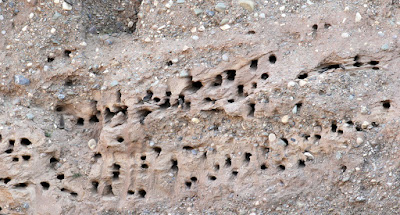After our not very productive ringing of Saturday, and on a slightly marginal forecast, we decided to have another go at Oakenclough on Monday. Well, after all, it is spring when many millions of birds migrate from Africa to Europe, so we might just catch a few.
I met Andy at 0615 where he was already busy with setting the mist nets in a less than ideal 10 mph breeze but partly sheltered situation. We caught better but with a truncated finish at 1030 due to the ever strengthening easterly wind.
There was little obvious migration however most of our catch of 15 birds proved to probable migrants - 5 Siskin , 3 Willow Warbler, 2 Blackcap, 2 Lesser Redpoll, 1 Goldfinch, 1 Chiffchaff and 1 Wren.
This has been a pretty poor year for Lesser Redpolls, our catches below expectations. The two on Monday could well be the last until their autumn migration begins.
Blackcap
Willow Warbler and Chiffchaff are both “phylloscopus” warblers, which means they are in the same bird family as each other. They also look very alike. They are both small birds with slender legs and bill. They both show greyish green and white plumage with no striking features. Field identification isn't helped by the fact that they are both very lively birds; constantly on the move, flicking through the foliage in search of flies and insects.
Leg colour may be the easiest way to separate Chiffchaff from Willow Warbler, and while it is not fool proof it is mostly a good guideline. Chiffchaffs have black legs and Willow Warblers have light brown, flesh coloured legs. The problem with this feature is that Willow Warbler leg colour can sometimes vary and birds with dark legs have been seen but this is the rare exception to the rule.
Willow Warblers tend to have more pronounced supercilium but not always so, especially in the autumn time.
The songs of these birds could not be more different and are well worth learning. Chiffchaff is a very easy song to remember as the bird simply says its name over and over again. A loud chiff-chaff, chiff-chaff, chiff-chaff. The call is a loud "hweet". Willow Warblers have a very fluid like song consisting of descending notes and once learned is easy to remember. Call is a loud "hoo-eet".
Although both warblers are ground nesters, Chiffchaffs tend to inhabit taller stands of deciduous trees and woodland. Willow Warblers can be found in a variety of habitat, from parks and gardens to hedges and willow copses. While on passage in spring and autumn both warblers can be found virtually anywhere.
If you ask any experienced birder how to tell Willow Warbler from Chiffchaff, they will tell you that primary projection is the proper way to do it and as so it's worth explaining. It's not as hard as it sounds but it does requires a basic knowledge of bird topography, in particular the different groups of wing feathers and where they are situated. Basically it is the length that the primaries extend past the tertials and how this relates to the tertial length e.g. in the figure below the primary feather projection is only half the length of the tertials in Chiffchaffs. Whereas in Willow Warblers the primary projection is equal to the length of the tertials.
Wings of Willow Warbler and Chiffchaff - PJ Grant
This “wing formula” gives a Willow Warbler a longer wing and also indicates that Willow Warblers travel further on migration - all the way to tropical Africa compared to Chiffchaff which winters in the Mediterranean and North Africa.
Linking this post to Anni's Birding and to Eileen's Saturday Birds. Take a look.
Linking this post to Anni's Birding and to Eileen's Saturday Birds. Take a look.






















































.jpg)












